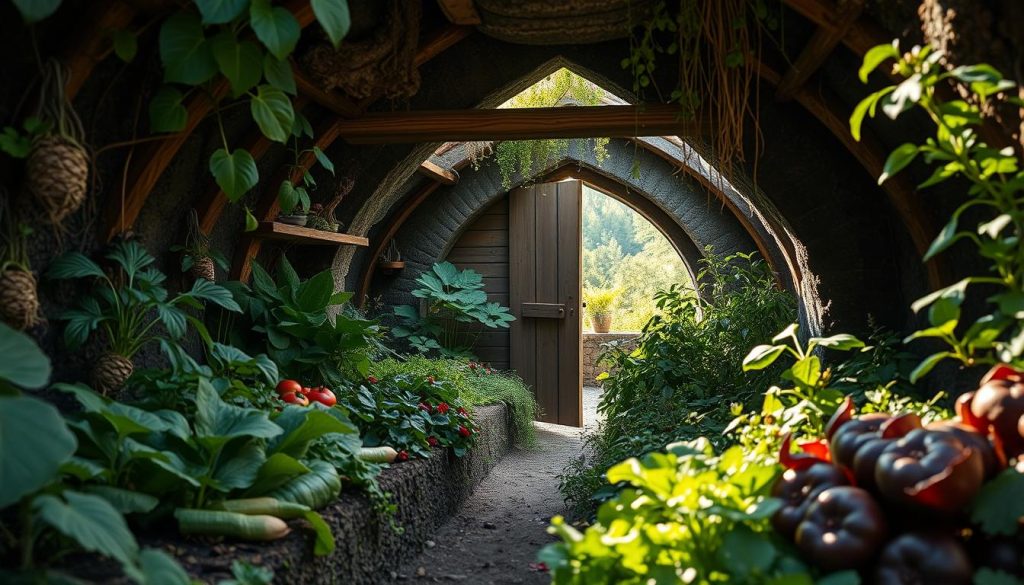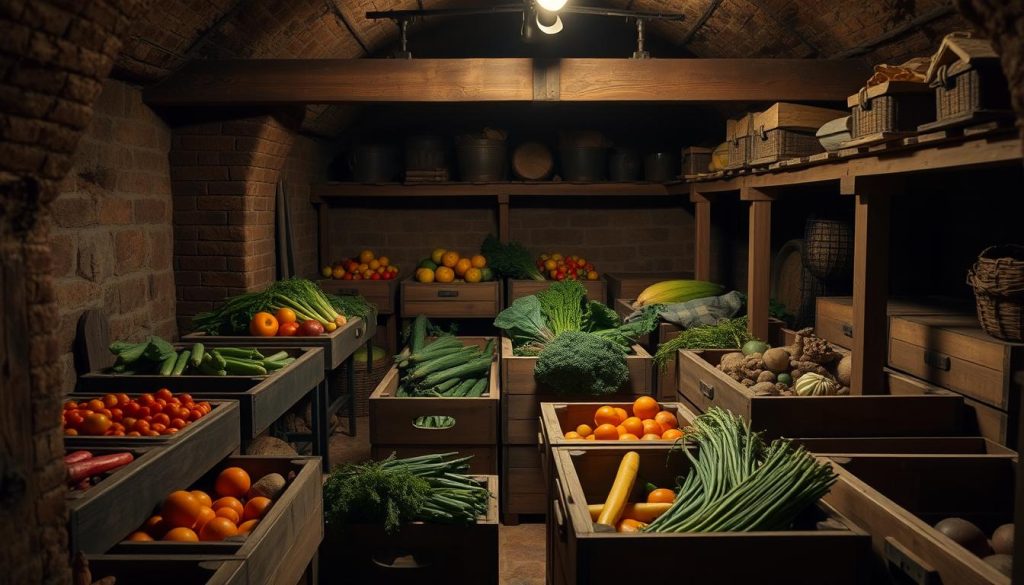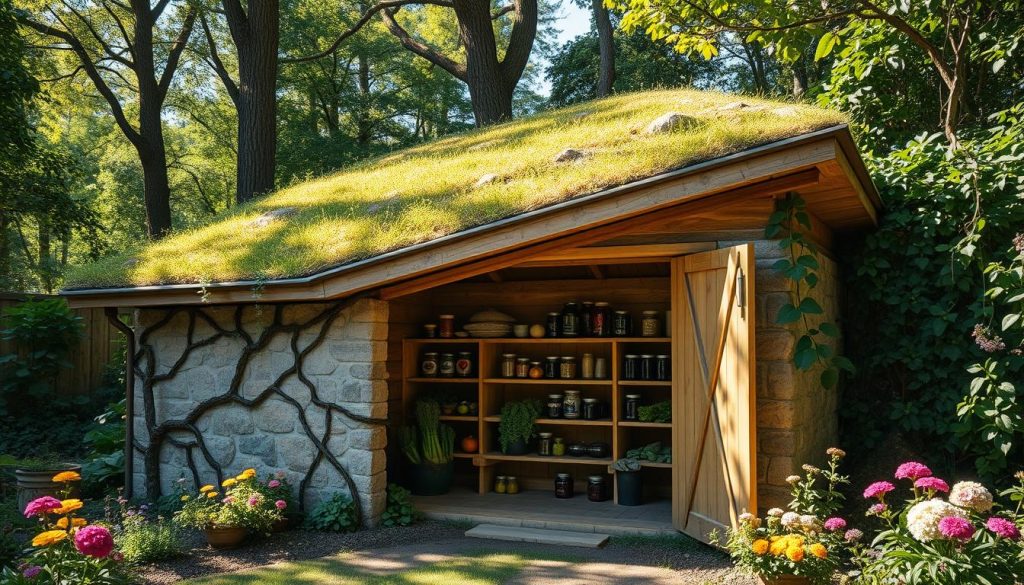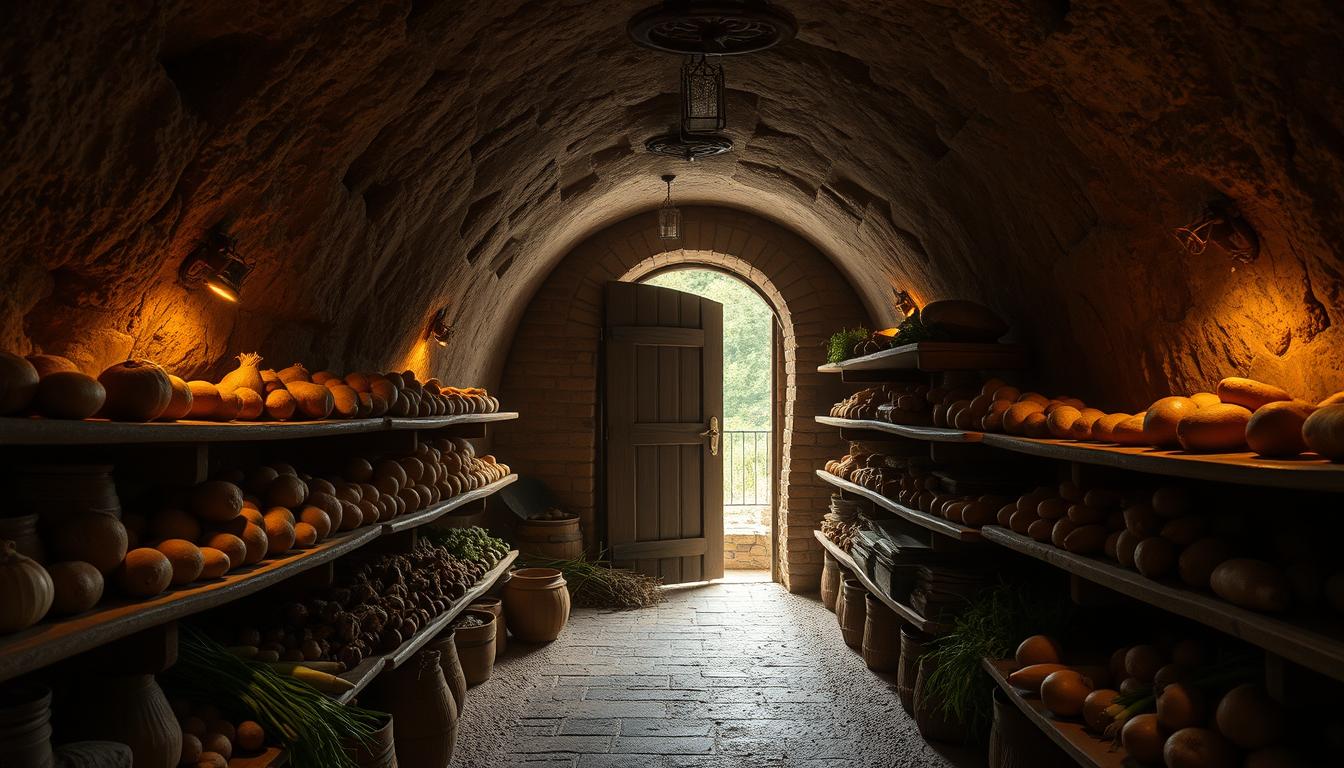Recently, more people are looking for home storage solutions that are good for the planet. Root cellars are a great way to keep vegetables and fruits fresh without using electricity.
Root cellars have been around for a long time, even before we had refrigerators. They use the earth’s cool and humid air to keep food fresh. This makes them a great choice for those who want to be more self-sufficient.
In this article, I’ll show you how to build a root cellar, no matter the size of your space. Whether you have a big backyard or a small indoor area, there’s a root cellar for you. Let’s dive into how these old-fashioned storage solutions are becoming popular again. They help us live more sustainably at home.
Understanding the Benefits of a Root Cellar
Building a root cellar offers many benefits for food preservation and saving energy. It keeps produce fresh for longer by controlling humidity and cooling naturally. This not only helps in storing food for a long time but also cuts down on utility bills.
What is a Root Cellar?
A root cellar is an underground space for storing vegetables, fruits, and other perishables. It uses the earth’s natural insulation to control temperature and humidity. This makes it great for keeping food fresh for a long time.
Reasons to Build Your Own
There are good reasons to build your own root cellar. It helps save energy by not needing electric refrigeration. It also helps preserve food, reducing waste and saving money. Plus, it supports a self-sufficient lifestyle.
Ideal Uses for a Root Cellar
A root cellar is great for storing many types of produce. It’s perfect for root vegetables like potatoes and carrots. It also works well for fruits like apples and pears, and canned goods. This makes it a valuable tool for storing food for a long time.
Choosing the Right Location for Your Root Cellar

Choosing the right spot for your root cellar is key to its success. By thinking about important factors, you can make a storage space that works well and is good for the environment.
Factors to Consider
Several things affect where to put your root cellar. The climate is important because you want cool, steady temperatures to keep food fresh. The soil should drain well to avoid water problems. Being close to your house makes it easier to get to.
Best Locations in Your Home
Your home has many spots for a root cellar. Basements are great because they’re already insulated and easy to get to. Garages can be good too, especially if they stay at a steady temperature. If your house sits on a slope, you can build a root cellar into the hillside. Planning well is crucial.
Minimizing Environmental Impact
It’s also important to think about the environment when building your root cellar. Try to disturb the land as little as possible and choose materials that are good for the planet. Good drainage helps manage water, and using eco-friendly materials is a step in the right direction.
Choosing the right spot for your root cellar, with care for the environment, makes it useful and kind to nature. Your careful planning and choice of materials ensure your root cellar is both practical and sustainable.
Simple DIY Root Cellar Designs

Building your own root cellar is easy and rewarding. We’ll explore simple designs for your project. These include traditional and modern approaches.
Buried Root Cellar
The buried root cellar is a top choice for many. It uses the earth’s natural insulation to keep food cool. Choose a dry, cool spot in your yard for it.
Dig a hole deep enough for your structure. Line the walls and floor with concrete or stone. This keeps pests out and makes it last longer.
Cool Storage Bins
Homemade cool bins are quick and easy to make. Use wooden crates, insulation foam, and aluminum foil. They work by insulating to keep temperatures right.
Place these bins in a shaded area. They’re great for storing fruits, veggies, and more. They’re easy to access and keep food fresh.
Fruit and Vegetable Storage Cages
Fruit and veggie storage cages are neat and functional. Make them with wire mesh and wooden frames. They have multiple levels for easy storage.
These cages improve air flow and make sorting produce simple. You can add them to a root cellar or use them alone in a cool, dry spot.
These designs let you customize your food storage. Whether you prefer underground or modern bins, you can do it. With some planning, you can keep your harvest fresh all year.
Building a Root Cellar Above Ground

Building an above-ground root cellar is a great choice for those who can’t have an underground one. A well-made above-ground cellar keeps your food fresh by controlling temperature and humidity. This way, your produce stays good for longer.
Site Selection
Choosing the right spot for your above-ground root cellar is the first step. Pick a place that gets natural shade, like the north side of your house or under trees. This keeps the cellar cooler.
The area should also drain well to avoid moisture problems. Too much moisture can harm your stored food.
Construction Tips
When building the walls and doors, use materials that hold heat well. Concrete or stone are good choices because they keep heat in. This helps keep the cellar’s temperature steady.
Adding insulation like foam boards or spray foam makes it even better. This stops temperature changes that can spoil your food.
Ventilation and Temperature Control
Good ventilation is crucial for keeping the right temperature and stopping mold. Put a vent pipe near the ceiling to let out warm air. Another pipe near the floor brings in cooler air.
This setup keeps air moving and controls humidity. Check and adjust the vents often to keep everything just right.
By picking the right spot, building it well, and adding good ventilation, you can make a reliable above-ground root cellar. It will keep your food fresh all year.
Creative Alternatives to Traditional Root Cellars
Digging a new root cellar might not be easy, but you can still enjoy its benefits. Let’s look at some creative ways to use existing spaces in your home as root cellars.
Repurposed Basements
Converting part of your basement is a smart alternative. Basements are cooler and more stable than above-ground areas. You can turn them into a storage spot for your homegrown food. Just add insulation and shelving to make the most of it.
Wine Cellars as Root Cellars
Got a wine cellar? It could be a great spot for storing fruits and veggies too. Wine cellars keep temperatures and humidity just right for food storage. This way, you can use your space more efficiently.
Using Garage Space
Transforming your garage into a storage area is another clever idea. Add shelves, insulation, and ventilation to make it perfect for storing food. Garages are often cool, which helps keep your produce fresh.
Essential Materials for Your Root Cellar
Building a root cellar is a fun DIY project. You need the right materials for it to work well and last long. I’ll show you what you need, like insulation, waterproofing, and green materials.
Insulation Options
Keeping your cellar’s temperature and humidity right is key. You have many eco-friendly insulation options:
- Cork Insulation: It’s good against moisture and lasts long.
- Sheep Wool: It keeps warm well and is good for the planet.
- Hemp Insulation: It insulates well and is kind to the environment.
Waterproofing Techniques
Keeping your cellar dry is important to avoid damage and mold. Here are some ways to do it:
- Bituminous Coating: It’s great for keeping moisture out of cellar walls.
- EPDM Membrane: It’s tough and bends to seal water out.
- Bentonite Clay: It’s natural and swells to block water.
Sustainable Materials
Using recycled and green materials is good for the planet. Here are some ideas:
- Recycled Lumber: Use wood from old projects or torn-down buildings.
- Reclaimed Brick: It looks old and is strong.
- Salvaged Metal: It’s great for adding strength and structure.
Using these materials makes your root cellar useful and green. Choose the right insulation, use good waterproofing, and pick recycled materials. This way, your root cellar will work well and be kind to the earth.
Maintaining Your Root Cellar
Keeping your root cellar in good shape is key. It helps keep the space and what’s stored in it in top condition. With a few simple steps, you can handle pests, prevent decay, and adjust to the seasons.
Regular Checks and Maintenance
Regular checks are essential for a well-maintained root cellar. I suggest setting a schedule to check the cellar’s structure and the stored items. Look for water leaks, mold, and temperature issues. Fix these problems right away to avoid bigger issues later.
Preventing Pests and Decay
Keeping pests out is crucial for a healthy root cellar. Use natural repellents like cedar chips or diatomaceous earth to keep pests away. Also, good ventilation helps prevent decay by reducing humidity that attracts mold and pests.
Seasonal Adjustments
Adjusting to the seasons is important for your root cellar all year. In cold months, add more insulation to keep the temperature steady. In warm months, improve airflow to avoid overheating. Use a thermometer to check the cellar’s temperature and make adjustments as needed.
What to Store in Your DIY Root Cellar
Knowing what to store in your DIY root cellar is crucial. It helps keep vegetables fresh longer and preserves fruits better. A well-stocked root cellar can greatly improve your home storage. Let’s look at the best vegetables, fruits, and preserves to store.
Best Vegetables for Root Cellaring
Root cellars are great for keeping root vegetables and hardy greens fresh. Potatoes, carrots, beets, and turnips are perfect for this. They can last months, giving you fresh produce all winter.
Leafy greens like kale and cabbage also do well in root cellars. They thrive in the cool, humid environment.
Fruits and Other Produce
Root cellars are not just for vegetables. They’re also great for fruit preservation. Apples, pears, and hardy citrus fruits like lemons can be stored here. Squash and pumpkins also benefit from the dark, cool space.
Remember, following storage tips is key. Keep fruit off the ground and check for spoilage often. This helps extend your harvest’s life.
Canned Goods and Preserves
Your root cellar is also ideal for home canning storage. Jars of jellies, jams, and canned vegetables do well here. The cool temperature and humidity keep them safe and tasty.
Using your root cellar for these items saves pantry space. It also keeps your homemade goods in top condition.
Troubleshooting Common Root Cellar Issues
Even the best root cellars can face problems. It’s important to spot and fix these issues early. This keeps your storage space working well. Let’s look at how to handle too much moisture, temperature changes, and pests.
Dealing with Excess Moisture
Too much moisture is a big problem for root cellars. Make sure your cellar has good airflow. You might need desiccants like silica gel or a dehumidifier. Also, check for leaks and seal any cracks to keep water out.
Managing Temperature Fluctuations
Keeping the temperature stable is crucial for food quality. Use insulation like foam board or straw bales. A thermometer helps track temperature changes. If the temperature swings too much, adjust the ventilation or add heating or cooling.
Addressing Pest Problems
Keeping pests away is vital for your stored food. Use wire mesh to block entry points and natural repellents like peppermint oil. Regularly check and clean the area, removing bad food to avoid attracting pests.

